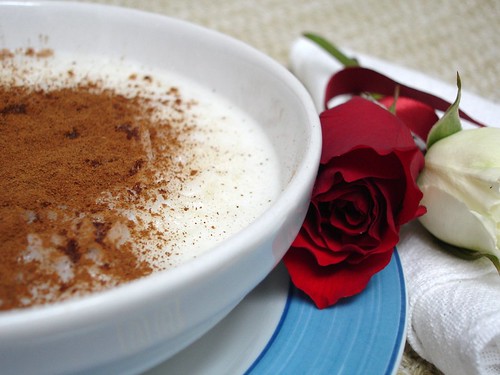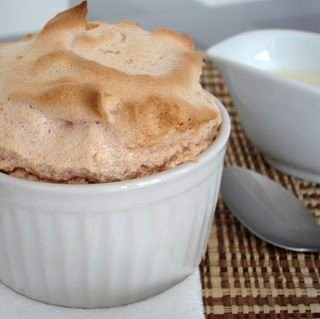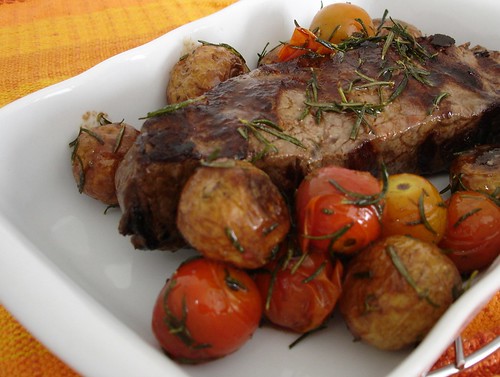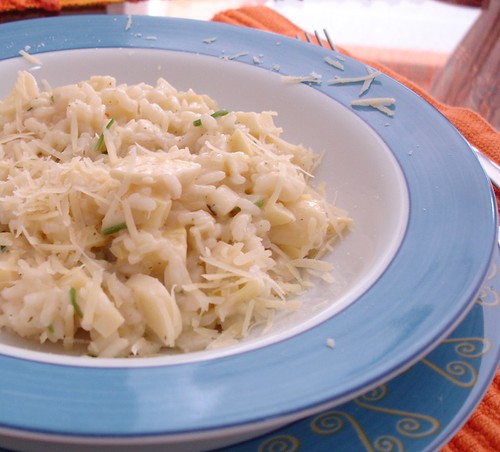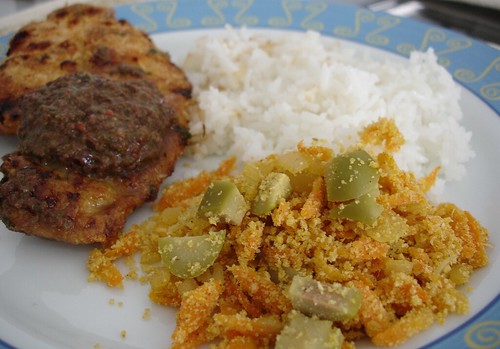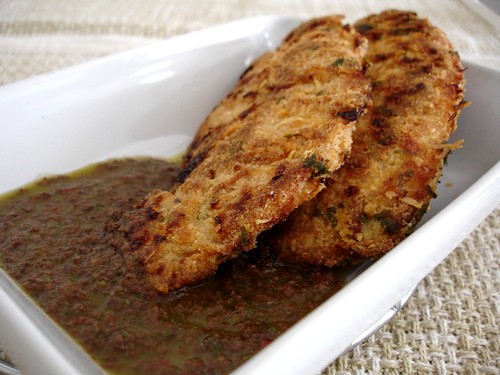Valentina is hosting an event for blogs in Portuguese called “My Favorite Dish”. We are supposed to cook and post our favorite food as kids - savory or sweet.
This is the recipe I chose to participate.
My mom used to make this sort of rice pudding – it was more liquid and I would eat it hot, sprinkled with tons of cinnamon, to keep warm in cold days.
The thing is I loved this rice pudding so much that I would ask my mom to make it even in hot, sunny days. :D
I hadn’t had this dish in ages and I was so glad to eat it again.
Thank you, my dear friend, for presenting the opportunity for such a special moment.
My mom’s rice pudding
60g rice, washed and dry – I use long grain
350ml water
150ml boiling milk – I used low fat
3 tablespoons sugar
pinch of salt
1 cinnamon bark
ground cinnamon to taste
Boil the water with the cinnamon bark and add the rice. Cook over high heat until it’s al dente – 8 minutes or so.
Add the milk and sugar and cook over low heat until the rice is tender – 10-12 minutes.
Remove from heat and serve at once, hot, sprinkled with ground cinnamon.
Wednesday, January 31, 2007
My mom’s rice pudding
Friday, January 26, 2007
Hay, Hay, it's Donna Day: Guava soufflé with catupiry sauce
I’ve always wanted to take part in foodblog events – 2 months after starting the English version of my blog, I decided to do so.
Tami of Running with Tweezers is hosting “Hay, hay, it’s Donna Day” this time – she was very kind and quickly answered the email I sent her, full of questions and doubts.
I decided to use a very Brazilian recipe - Guava soufflé with catupiry sauce.
Catupiry is a popular kind of cream cheese here and it’s used in many dishes, as pizza topping, pie filling, etc.
This souffle was inspired by a dessert called “Romeo and Juliet” – guava paste served with a sort of cheese called Minas cheese, or catupiry (pictured below): It was my first souffle, so I was quite apprehensive…
It was my first souffle, so I was quite apprehensive…
I loved its flavor and texture. But I have to be honest: the sauce was too mild in my opinion. I guess that a drop of honey would make it more interesting, without altering the color or too much of the flavor– I’ll be making this souffle again and will try to adjust the sauce to my taste.
This recipe was created by Carla Pernambuco, a wonderful Brazilian chef that has been mentioned by Patricia Wells in The New York Times.
UPDATE: a dear friend of mine told me that it's possible to make this sauce replacing the catupiry with mascarpone
Guava soufflé with catupiry sauce
Sauce:
200ml milk
100g catupiry cheese
Souffle:
4 egg whites
pinch of salt
220g creamy guava marmalade*
For the sauce: cook the milk and the catupiry in a double boiler – or use a heatproof bowl over simmering water - and beat well with a whisk until you have a smooth even sauce. Set aside to cool.
Preheat the oven to 160ºC/320ºF.
For the souffle: beat the egg whites until soft peaks form – add the salt. Continue beating until stiff peaks form. Gradually add the guava marmalade to the egg whites and mix well with a whisk.Spoon the mixture into the ramekins and place on a baking tray. Bake for 10 minutes or until puffed – increase the oven temperature in the end of the cooking process to make the soufflés golden. Do not open the oven while cooking. Serve immediately with the cool sauce.
*You can use guava paste instead of marmalade – that’s what I used.
Chop the paste in small pieces, add a little water and cook over low heat, stirring constantly with a whisk, until creamy and silky. Set aside to cool before using it.
Serves 4 – I halved the recipe and still got 4 ramekins, 10cm diameter each.
Wednesday, January 24, 2007
World Peace Cookies
Jenjen made them. Deb made them too. So did Anita.
“There must be something about these cookies…” I thought. Something really good to cause such a commotion.
The only way to find that out was to bake them – and here you are, ladies and gentlemen: one of the most delicious cookies I have ever eaten, certainly the most delicious I have ever baked.
My cookies turned out great but they tended to be a little bit softer instead of crispy. I would love to hear your opinion about it – did I make them correctly?
World Peace Cookies
175g all-purpose flour
30g unsweetened cocoa powder
½ teaspoon baking soda
155g unsalted butter, at room temperature
145g light brown sugar
50g caster sugar
½ teaspoon fleur de sel or ¼ teaspoon fine sea salt – I used salt
1 teaspoon pure vanilla extract
140g bittersweet chocolate, chopped into chips, or a generous ¾ cup mini chocolate chips – I used semisweet but will bake them again using bittersweet
Sift the flour, cocoa and baking powder together.
Beat the butter until soft and creamy. Add both sugars, the salt and vanilla extract and beat for 2 minutes more.
Pour in the dry ingredients and mix just until combined - for the best texture, work the dough as little as possible once the flour is added, and don’t be concerned if the dough looks a little crumbly.
Toss in the chocolate pieces and mix only to incorporate.
Turn the dough out onto a work surface, gather it together and divide it in half – I weighed the dough to make sure the parts would be even.
Working with one half at a time, shape the dough into logs that are 4cm in diameter. Wrap them in plastic wrap and refrigerate them for at least 3 hours* - the dough can be refrigerated for up to 3 days or frozen for up to 2 months. If you’ve frozen the dough, you needn’t defrost it before making- bake for 1 minute longer.
Preheat oven to 160˚C and line two baking sheets with parchment paper or silicone mats.
Using a sharp knife, slice the logs into rounds that are 1 cm thick - the rounds are likely to crack as you’re cutting them- don’t be concerned, just squeeze the bits back onto each cookie.
Arrange the rounds on the baking sheets, leaving about 3cm between them.
Bake the cookies on sheet at a time for 12 minutes- they won’t look done, nor will they be firm, but that’s just the way they should be.
Let the cookies rest on the baking sheet until they’re cold – that’s when they’ll be firm.
Serve them warm or at room temperature.
Makes 36 cookies – I got 46.
* Anita was the only one who wrote to refrigerate them for 1 hour. I did as she said because I was short on time – it worked fine because the dough was already pretty hard.
Monday, January 22, 2007
Striploin with golden new potatoes, rosemary and tomatoes
An important Brazilian magazine launched a special edition with chefs’ profiles and recipes – Joao bought it for me.
I made a recipe from the magazine right after I got it but it didn’t work out – there was something wrong with the amount of flour. I’ll try it again some time.
I was flipping through the magazine the other day, determined to try a new recipe, when I saw this beautiful piece of beef with rosemary leaves. I had just come back from my grandmother’s house with a huge bunch of rosemary that she had picked from her garden.
It was a perfect coincidence.
I made ¼ recipe and it serves one really well: Joao had half of it for lunch and the other half I cut in strips, cooked quickly with finely chopped onions and served with bread as a Sunday night snack.
After slicing the beef, I noticed that the center part was too rare for Joao’s taste – so I grilled the steaks for 1 minute or so.
Striploin with golden new potatoes, rosemary and tomatoes
800g new potatoes
50g fresh rosemary
8 tablespoons olive oil
200g cherry tomatoes
1 tablespoon balsamic vinegar
1,6kg striploin*
4 tablespoons Dijon mustard
salt and cracked black pepper
Cook the potatoes in salted water. Drain and set aside.
Remove the rosemary leaves and cook them in the olive oil until they’re crisp and crunchy. Drain and set both the oil and the rosemary aside.
Bring a frying pan to high heat and cook the tomatoes with 2 tablespoons of the reserved oil. Season with salt and pepper and cook until they’re golden. Remove from heat, add the vinegar and set aside.
Place the potatoes in a baking dish, season with salt and pepper and bake in a 220ºC/425ºF oven until they’re golden. Set aside.
Divide the beef in 4 pieces of 400g each. Season them with salt and pepper.
Heat up a broiler/grill – I used a frying pan like this – and grill the beef with the olive oil, saving 1 tablespoon. Grill both sides to your taste.
Heat the potatoes, tomatoes and rosemary in a saucepan, add the remaining oil and check salt and pepper.
Serve the beef with this mix and the mustard.
Serves 4.
*The beef cut I used is actually the interior part of the striploin.
Friday, January 19, 2007
Hearts of palm risotto
My dear friend came to Brazil last month and we had lunch together – it was wonderful!
We ended up ordering the same dish and just noticed that when the waiter brought our food. :D
It was a heart of palm and snow pea risotto. It was delicious and I tried to recreate a similar recipe at home.
I chose not to use the snow peas and focused on the heart of palm – I cook with it often and have posted one snack recipe with it.
I liked the result and decided to share it with you.
UPDATE: Lydia asked my about canned hearts of palm - for this risotto, it's important that the hearts of palm are soft, because they're not cooked for long with the rice. I think they would work fine, Lydia! Just make sure you soak them in water if they're too salty.
Hearts of palm risotto
1 tablespoon butter
1 tablespoon olive oil
½ small onion, chopped
140g Arborio rice
60ml dry white wine
700ml vegetable stock
2-3 hearts of palm, sliced
20g Parmesan cheese, grated
1 tablespoon parsley, chopped
1 tablespoon cold butter
salt and pepper – I used only salt
Bring stock to a boil in a medium saucepan.
In a large pan, heat olive oil and butter over high heat. Add the onion and cook until it’s transparent.
Pour in the rice and stir for 1 minute; add the wine and stir until it's absorbed.
Add the stock - 1 ladleful at a time - and stir constantly until it's absorbed. Repeat this step until the rice is al dente.
One minute before it’s ready, add the hearts of palm and mix well.
Remove from heat, add butter, parsley and cheese and mix well. Add salt and pepper to taste, if desired.
Serve immediately.
Serves 2.
Wednesday, January 17, 2007
Tenderloin medallions with carrot “farofa” - updated post
It’s amazing how many people I’ve been in contact with since I discovered the delicious (yep, pun intended) foodblog world – and then started my own blog.
People who share the passion for food I have, people who understand the excitement of trying a new recipe, of cooking for family and friends, of tasting new ingredients for the first time.
One of these people is Terry, from Blue Kitchen – a blog you’ll get addicted to visiting, I can assure you.
Terry and I exchanged some e-mails after I wrote a comment on his blog about a very Brazilian dish - rice and beans. He said he would cook it – I crossed my fingers (and toes, as well, just in case) hoping we would like it.
He did like it and made a beautiful post about it!
Thanks, Terry! I loved your post and I’m very glad to be a part of your fantastic blog.
To keep on the Brazilian food theme, I’ll post a “farofa” recipe – click here to know more about farofa.
This is a bit different farofa, for the recipe calls for grated carrots – one way my grandmother found to make my brother eat at least one more kind of vegetable, besides French fries.
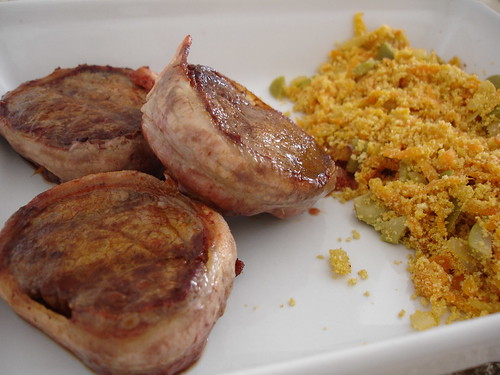
I used to cook this dish all the time when I was single and lived with my father and my brother – who still won’t eat anything green.
I still make it now because Joao loves it.
A simple side dish, quick to put together and that goes well with many things.
UPDATE: I make this farofa quite often, almost weekly during quarantine. It is delicious and also a family treasure. I have updated the recipe just to make it more like the version I make nowadays.
Tenderloin medallions with carrot “farofa”
4 tenderloin medallions
4 rashers of bacon
salt and cracked black pepper
1 tablespoon olive oil
Farofa:
2 tablespoons olive oil
½ small onion, finely diced
1 garlic clove, minced
1 large carrot, peeled and coarsely grated
salt and freshly ground black pepper
2 tablespoons finely chopped green olives
3 tablespoons chopped parsley leaves
70g manioc flour
Season the medallions with salt and pepper.
Wrap each medallion with a rasher of bacon and secure it with a toothpick.
Heat the olive oil over medium-high heat and grill the medallions to your liking.
Remove toothpicks and serve.
I served the medallions with the sauce found in this recipe.
For the farofa:
Heat the olive oil in a large frying pan over medium-high heat. Add the onion and cook,stirring occasionally, until translucent. Add the garlic and cook for 1 minute only - do not let it burn or it will get bitter. Add the carrot, cook for 2-3 minutes or until soft. Season with salt and pepper, add the parsley and the olives and mix. Stir in the manioc flour and cook for 1 minute. Remove from the heat and serve.
Serves 4 – or 2, depending on how hungry they are!
Monday, January 15, 2007
Parmesan chicken
I printed this recipe the minute my dear friend Valentina posted it - but it took me a good 4 months to make it. I shouldn’t have waited that long – this dish is delicious!
I love to try new chicken recipes and this one won my heart when I saw it called for Parmesan cheese.
The crust is very crunchy and I like the idea of baking instead of deep-frying.
Valentina doesn’t mention how she seasoned the chicken, so I marinated it in lime juice, smashed garlic and salt. You can season it as you prefer.
The sauce is delicious and Joao (a.k.a. “picky eater”) loved it – I made tenderloin medallions for him and served with the same sauce. The only change was adding chilli pepper to the sauce – my husband’s idea.
Parmesan chicken
1 tablespoon flour
2 eggs, lightly beaten
80g breadcrumbs
20g grated Parmesan cheese
2 tablespoons chopped parsley
4 chicken breasts
pinch of salt
Sauce:
12g basil leaves or parsley – I used basil
120ml olive oil
60ml lime juice
1 clove garlic
80g black olives, pitted
1 large red chilli pepper - optional
Cover the chicken breasts with plastic wrap and gently flat them with a mallet, then slice them into 3 or 4 large strips – I asked my butcher to prepare the fillets for me, so I skipped this part. Season the chicken accordingly to your taste.
Preheat the oven to 220ºC (430ºF). Brush a baking dish with olive oil and set aside.
In a bowl, combine the eggs and flour. In another bowl mix breadcrumbs, Parmesan, parsley and salt. Dip the chicken fillets into the egg mixture then into crumb mixture to coat – I pressed it hard to get a thick crust.
Place the chicken pieces in the prepared baking dish. Do not overlap the pieces – they should remain separated. Bake for 15-20 minutes or until golden brown – turn the pieces upside down in half the time. Do it carefully not to tear the crumb.
For the sauce, combine all the ingredients in a food processor and blend well.
Serves 4
Thursday, January 11, 2007
Chocolate truffle cake
 This is the third – and last – dessert from the Christmas series. I must confess it’s my favorite...
This is the third – and last – dessert from the Christmas series. I must confess it’s my favorite...It was a pretty chocolate-y Christmas, as you can see. :D
Chocolate truffle cake
from Modern Classics Book 2
Cake:
68g all-purpose flour
2 tablespoons cocoa powder
75g caster sugar
4 eggs
80g butter, melted
Truffle filling:
450g dark couverture chocolate – I used semisweet Callebaut that’s made in Brazil with Belgian cocoa mass
480ml cream
6 egg yolks
75g caster sugar
Preheat the oven to 180ºC (350ºF).
Sift the flour and the cocoa three times and set aside. Place the sugar and eggs in the bowl of an electric mixer and beat for 8-10 minutes or until pale and thick and triple in volume.
Gently fold through the flour and cocoa and then the butter.
Line the base of a 20cm (8in) round springform tin with non-stick baking paper - I don’t have one, so I used a tin with a removable bottom, greased it, lined the base with paper, then greased it again and floured everything, just in case.
Pour the mixture and bake for 25 minutes or until the cake comes away from the side of the tin. Cool in the tin.
While the cake is baking, make the truffle filling:
Place the chocolate and cream in a saucepan over low heat and stir until melted and smooth. Place the egg yolks and sugar in a heatproof bowl over a saucepan of simmering water and beat for 6 minutes or until thick and creamy. Fold the chocolate mixture through the egg mixture and beat for 6 minutes or until cold. Refrigerate for 30 minutes.
To assemble, remove the cake from the tin and cut in half horizontally. Place the bottom layer back in the tin and pour over half of the truffle filling. Place the top layer on the cake and cover with the remaining filling. Refrigerate for 5 hours or until set.
To serve, place a warm tea towel around the tin, which will help ease the cake away from the side. Carefully remove the cake from the tin and use a heated palette knife to smooth the edge – I wasn’t able to do it, but I highly recommend it because the cake would look a lot nicer.
Serves 10-12.
During cooking the cake will shrink away from the side of the tin so that when you pour the truffle filling over the top, it will spread down the side of the cake and create a great smooth and glossy coating. To smooth the edge after removing the cake from the tin, dip a palette knife into hot water, dry it quickly with a tea towel and run the blade around the edge.
Tuesday, January 9, 2007
Bûche de Noël
 I had decided not to post this recipe because of its horrendous presentation – but this cake is so good that I thought I should share it with you.
I had decided not to post this recipe because of its horrendous presentation – but this cake is so good that I thought I should share it with you.It’s a very traditional recipe and maybe you already have your favorite version for it. I liked the cake a lot and I have thought about making it again as a jelly roll – Joao (my husband) loves jelly rolls.
I’ll make a dulce de leche roll as well – I’ll keep you posted. :D
Bûche de Noël
from The Williams-Sonoma Collection: Dessert
Cake:
140g all-purpose flour, plus extra for dusting
¾ teaspoon baking powder
¼ teaspoon salt
4 large eggs
145g granulated sugar – I used caster sugar
1 ¼ teaspoons vanilla extract
confectioner’s sugar for dusting
*Syrup:
60ml water
50g granulated sugar – I used caster sugar
2 or 3 tablespoons dark rum or coffee-flavored liqueur – I used vanilla extract, just a little
Frosting:
315g bittersweet chocolate, finely chopped – I used semisweet
560ml heavy cream
1 teaspoon vanilla extract
pinch of salt
Preheat the oven to 180ºC (350ºF). Grease a 40 x 28cm rimmed baking sheet pan and line the bottom with parchment paper. Grease and flour the paper and the pan sides.
For the cake: whisk the flour, baking powder and salt in a bowl. In a large bowl, using a mixer on medium-high speed, beat the eggs until pale and thick. Add the sugar and vanilla and continue beating until tripled in volume. Sprinkle the flour over the mix and, with a rubber spatula, fold gently until just blended.
Pour the batter into the prepared pan and spread evenly. Bake until the cake springs back when touched, 13-15 minutes.
While the cake is baking, lay a clean kitchen towel on the counter and sift confectioner’s sugar generously onto it, covering it evenly.
When the cake is ready, remove it from the oven and immediately run a knife around the inside of the pan to loosen the cake. Invert the cake onto the prepared towel and remove the paper carefully. Beginning on a long edge, roll up the cake and towel together. Set aside to cool.
To make the syrup, combine water and sugar in a small saucepan over medium heat and stir until the sugar dissolves. Bring to a boil and remove from heat. Stir in the rum and set aside to cool.
To make the frosting, combine the chocolate and cream in the top of a double boiler, set over barely simmering water and melt the chocolate, then whisk until blended – I used a regular pan and melted chocolate and cream over low heat, stirring constantly.
Refrigerate the mixture for about 2 hours; you can use an ice bath to speed the process.
When the mixture is cold, add vanilla and salt and, using a mixer on medium-high speed, beat it until firm enough to hold a soft dollop.
To assemble the bûche, unroll the cake and brush it with the syrup. Spread one-third of the ganache over the cake and gently reroll it. Place seamed side down on a plate and frost the cake with the remaining ganache, using firm and rough strokes – you need to make it look like a log. Trim ends with a serrated knife – I covered the ends with ganache as well.
Garnish with chocolate curls, confectioner’s sugar – I replaced it with cocoa powder - and meringue mushrooms.
I wouldn’t have time to prepare meringue mushrooms so I made mine with sugarpaste/rolled fondant. Just be careful because not to place sugarpaste/rolled fondant in the fridge.
Serves 12-16
* There was too much syrup left. I think half the amount is enough.
Friday, January 5, 2007
Ebony & Ivory "Pavê"
 We spent Christmas' Eve at my sister-in-law's and I was in charge of making dessert. With this "excuse" I was able to prepare something I was missing so much, because of the stupid diet I'm on. I got wild and made 3 different desserts. And yes, my dear, I made Donna Hay's truffle cake, too. :D
We spent Christmas' Eve at my sister-in-law's and I was in charge of making dessert. With this "excuse" I was able to prepare something I was missing so much, because of the stupid diet I'm on. I got wild and made 3 different desserts. And yes, my dear, I made Donna Hay's truffle cake, too. :DThe pictures are awful because we arrived there very late (it was 11:40pm), there was no room for the desserts and my camera battery would die any minute. It's like the old saying, haste makes waste. :S
This is a very popular dessert here in Brazil, called "pavê". It's similar to a trifle, but the recipe calls for ladyfinger cookies instead of sponge cake. You can use savoiardis, as well. Click here to check Haalo's beautiful savoiardis.
The preparation of this dessert resembles the way tiramisu is prepared.
I don't listen to Beatles or Paul McCartney - I'm a Smiths kind of gal - but the song came to my mind the minute I finished making the "pavê". So I decided that the original name - two-toned pavê - was not as nice and changed it.
Recipe from here - there's not an English version for this recipe there, but this site is worth visiting since there are other delicious recipes, too.
Ebony & Ivory "Pavê"
5 egg yolks
160g sugar
3 tablespoons cornstarch
500ml hot milk
1 teaspoon vanilla extract
1 tablespoon Cointreau or Grand Marnier - I had neither so I used the zest of 1 large orange
1 tablespoon butter
2 tablespoons cocoa powder
180g ladyfinger cookies
250ml orange juice
100g semisweet chocolate
100g white chocolate
Prepare the "custard": beat the egg yolks and sugar and add the cornstarch. Start adding the milk gradually. Beat well. Transfer the mixture to a saucepan and cook over low heat, stirring constantly until it thickens. Add the butter and cook for another minute, still stirring. Remove from heat, add Cointreau and vanilla and divide this cream in half: add cocoa powder to one half. Set aside to cool down.
To assemble the dessert, soak the cookies quickly in the orange juice and make layers: light custard, 8 cookies, dark custard, 8 cookies, and so on.
Make chocolate shavings and place them on top of the finished dessert.
Keep it in the fridge until serving.
Serves 8 - I doubled the recipe, that's why my "pavê" is so big!
Wednesday, January 3, 2007
Pizza
 Last week I invited my father and my brother over for dinner. The menu was... homemade pizza!
Last week I invited my father and my brother over for dinner. The menu was... homemade pizza!I got the recipe from Dough: Simple Contemporary Breads
I got 3 big pizzas with the dough - each one around 30cm large.
I had already made this recipe before, but I used all purpose flour and had to add more flour to get it right (something against the author's technique). But this time I used a special bread flour that was released here in Brazil and it worked perfectly!
The idea of posting pictures of the entire preparation process was my husband's, who also worked as the photographer. :D
Pizza
510g bread flour
15g fresh yeast
2 teaspoons salt
360ml water, room temperature
62ml olive oil
Place the flour in a large bowl. Add the yeast and rub it with the flour using your fingertips. Add the salt, water and olive oil and mix until you have a mixture that resembles porridge.
You won't knead the dough the way you are used to - instead, you'll use your fingers as if they were "forks" and lift the dough, swing it upwards and then slap it back down, away from you, onto the counter. It will be sticky, but go ahead. Have no fear. :D
Stretch the front of the dough towards you, then lift it back over itself to form an arc - this will trap the air - still stretching it forwards and sideways and tucking it in around the edges. Repeat this sequence until the dough is not sticky anymore.
Place the dough in a lightly floured bowl, cover and let it rest for 70 minutes or overnight in the freezer, for better crust and taste - mine rose for 3 hours.
Pre-heat the oven to 250ºC (475ºF)
Turn the dough onto a lightly floured surface, shape into a ball and let it rest for 10 minutes.
Divide the ball into three even parts.
Continue to work on an evenly floured surface so your dough won't stick to it.
Place the heel of your hand in the center of each ball and push it away from you to stretch the dough out. Keep stretching until you have a large round pizza - the book says 20-22cm, but mine were 30cm:
 Spread some tomato sauce on the dough - I was inspired that day so I made my own tomato sauce:
Spread some tomato sauce on the dough - I was inspired that day so I made my own tomato sauce:  Sprinkle with mozzarella, parmesan, basil leaves or whatever your imagination calls for - I made one with broccoli, olives, cheese and onions:
Sprinkle with mozzarella, parmesan, basil leaves or whatever your imagination calls for - I made one with broccoli, olives, cheese and onions: 

Makes 3 large pizzas
